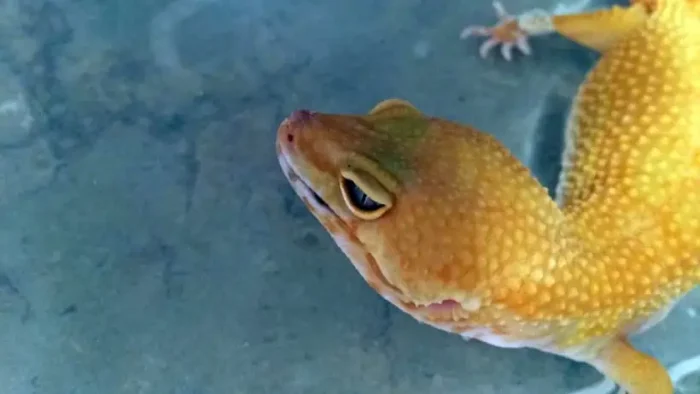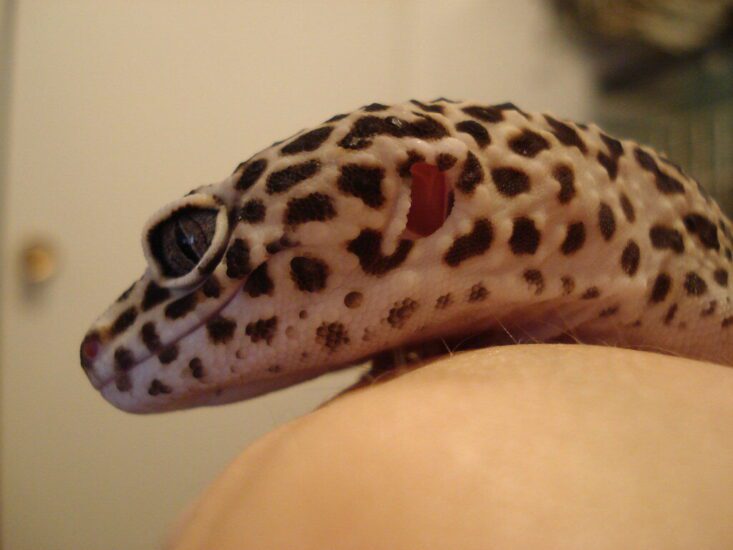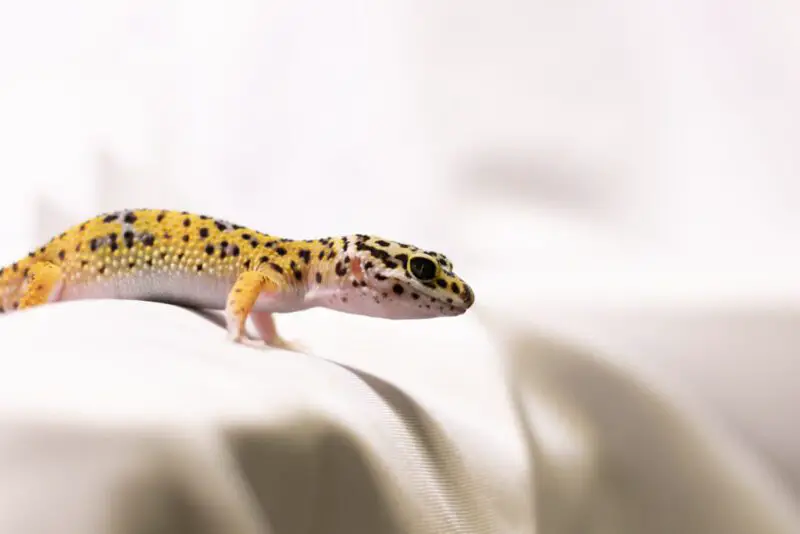
Leopard geckos are fascinating creatures that make great pets for reptile enthusiasts. These small, adorable creatures are low maintenance and easy to take care of, making them a popular choice among pet owners. However, as with any living being, leopard geckos are susceptible to illnesses and diseases that can affect their health and well-being. One of the most common health issues that affect leopard geckos is mouth rot. In this article, we’ll take a closer look at what leopard gecko mouth rot is, its causes, symptoms, and treatments, and how you can prevent it.
What is Leopard Gecko Mouth Rot?
Leopard gecko mouth rot, also known as infectious stomatitis, is a bacterial infection that affects the mouth and surrounding areas of leopard geckos. This bacterial infection can spread quickly if left untreated, leading to more severe health issues.
 Leopard Gecko Mouth Rot
Leopard Gecko Mouth Rot
Mouth rot is usually caused by poor hygiene, environmental factors, or a weakened immune system. For example, if the leopard gecko’s enclosure is not cleaned regularly or the water in their enclosure is not changed regularly, it can lead to a bacterial buildup that can cause mouth rot. Also, if the enclosure is too damp or not warm enough, it can weaken the gecko’s immune system, making them more susceptible to infections such as mouth rot.
Learn about the bacterial infection that affects the mouth and surrounding areas of leopard geckos.
Signs and Symptoms of Leopard Gecko Mouth Rot
The signs and symptoms of leopard gecko mouth rot can vary, but some of the most common include:
- Loss of appetite: If your leopard gecko suddenly stops eating or appears to be eating less than usual, it could be a sign of mouth rot.
- Swollen or discolored mouth: A leopard gecko’s mouth should be pink and healthy-looking. If you notice any swelling, redness, or discoloration, it could be a sign of mouth rot.
- Excessive drooling: If your leopard gecko is drooling excessively, it could be a sign of mouth pain or discomfort.
- Trouble closing the mouth: Mouth rot can make it difficult for leopard gecko to close their mouth, which can make eating and drinking difficult.
- Foul odor: A foul odor coming from your leopard gecko’s mouth can be a sign of mouth rot, as the bacteria that cause the infection can produce a strong smell.
If you notice any of these signs or symptoms, it’s important to seek veterinary care right away. Mouth rot can be a serious health issue that requires prompt treatment to prevent complications.
Recognize the common signs and symptoms of mouth rot to seek prompt veterinary care.
Causes of Leopard Gecko Mouth Rot
Leopard gecko mouth rot is caused by bacterial infections, typically from the overgrowth of naturally occurring bacteria in the mouth or from a lack of proper hygiene. Some common causes of mouth rot in leopard geckos include:
- Poor hygiene: Leopard geckos are susceptible to mouth rot if their enclosure isn’t kept clean. Bacteria can accumulate in food and water dishes, on cage furniture, or on any uneaten food left in the enclosure.
- Nutritional deficiencies: Leopard geckos require a balanced diet that meets their nutritional needs. A lack of certain nutrients can weaken their immune system, making them more susceptible to infections like mouth rot.
- Low humidity: Leopard geckos require a specific humidity level to stay healthy. If their enclosure is too dry, it can cause their mouth to become dry and make them more susceptible to infections.
- Stress: Stress can weaken a leopard gecko’s immune system, making them more susceptible to infections like mouth rot. Overhanding, overcrowding, or changes in their environment can all cause stress in leopard geckos.
Be aware of the common causes of mouth rot, including poor hygiene, nutritional deficiencies, low humidity, and stress.
Treatment for Leopard Gecko Mouth Rot
The treatment for leopard gecko mouth rot will depend on the severity of the infection. In mild cases, your veterinarian may recommend a course of antibiotics to help clear up the infection. However, in more severe cases, your leopard gecko may require more aggressive treatment, such as surgical debridement of infected tissue or even hospitalization.
In addition to antibiotics, there are several at-home treatments that can help alleviate the symptoms of leopard gecko mouth rot. These include:
- Warm Water Soaks: Soaking your leopard gecko’s mouth in warm water can help soothe the pain and inflammation associated with mouth rot. You can do this by filling a shallow dish with warm water and allowing your leopard gecko to soak in it for 10-15 minutes, 2-3 times a day.
- Oral Rinses: Your veterinarian may recommend an oral rinse to help kill the bacteria in your leopard gecko’s mouth. This can be done using a solution of diluted Betadine or chlorhexidine, which you can apply to your leopard gecko’s mouth using a cotton swab.
- Increased Humidity: Increasing the humidity in your leopard gecko’s enclosure can help alleviate the symptoms of mouth rot. You can do this by misting the enclosure with water or adding a humidifier.
- Soft Foods: If your leopard gecko is having trouble eating, you may need to offer them soft or liquid foods, such as pureed chicken or baby food.
Understand the various treatment options for mouth rot, including antibiotics, warm water soaking oral rinses, increased humidity, and soft foods.
Leopard Gecko Mouth Rot
Preventing Leopard Gecko Mouth Rot
Preventing leopard gecko mouth rot is easier than treating it. Some simple steps you can take to prevent mouth rot in your leopard gecko include:
- Keep their enclosure clean: Regularly clean and disinfect your leopard gecko’s enclosure, including food and water dishes.
- Provide proper nutrition: Offer your leopard gecko a balanced diet that meets its nutritional needs.
- Maintain proper humidity: Keep the humidity in your leopard gecko’s enclosure at the appropriate level to prevent dry mouth.
- Reduce stress: Try to minimize stress in your leopard gecko’s environment by avoiding overhandling, overcrowding, and sudden changes.
- Regular check-ups: Take your leopard gecko to the veterinarian for regular check-ups to catch any potential health issues early on.
Take preventive measures to maintain a clean and suitable living environment for your leopard gecko, such as regularly cleaning and disinfecting their habitat, providing proper nutrition, and reducing stress.
Tips for Leopard Gecko Health

In addition to preventing and treating mouth rot, there are several other steps you can take to keep your leopard gecko healthy and happy. Providing a proper diet is crucial, so make sure to feed your gecko a diet of live insects and other healthy foods.
Maintaining a suitable temperature and humidity level in their enclosure is also essential for their overall health. Regularly clean and disinfect their habitat, including their food and water dishes, to prevent infections and parasites.
Reduce stress by avoiding excessive handling and providing plenty of hiding spots and other enrichment activities. And finally, take your leopard gecko to the veterinarian for regular check-ups to ensure they are in good health.
Conclusion
In conclusion, leopard gecko mouth rot is a serious health issue that requires prompt treatment. It’s important to be aware of the signs and symptoms of mouth rot and to take steps to prevent it from occurring in the first place. By maintaining proper hygiene, providing proper nutrition, and reducing stress, you can help keep your leopard gecko healthy and happy. And if you do notice any signs of mouth rot, don’t hesitate to seek veterinary care right away. With prompt treatment, your leopard gecko can make a full recovery and continue to thrive as a beloved pet.
FAQs
If you’re a leopard gecko owner, it’s natural to have questions about mouth rot and how to care for your pet. Here are a few common FAQs to help you better understand this condition:
Yes, mouth rot can be highly contagious among reptiles, and it’s important to keep any infected geckos isolated from other animals to prevent the spread of infection.
While there are many home remedies and natural treatments touted as effective for treating mouth rot in geckos, it’s important to remember that this is a serious infection that requires professional veterinary care. Attempting to treat the condition on your own can lead to complications or further spread of the infection.
Symptoms of mouth rot can vary, but some common signs include swollen or inflamed gums, pus or discharge around the mouth, and a decrease in appetite or activity. If you suspect your gecko may have mouth rot or any other health issue, it’s important to seek veterinary care as soon as possible.
While it’s not always possible to prevent every case of mouth rot, there are several steps you can take to minimize the risk. Keeping your gecko’s enclosure clean and well-maintained, providing a nutritious and balanced diet, and minimizing stress and handling can all help promote overall health and prevent infections.
By staying informed and working closely with your veterinarian, you can help ensure the best possible care for your leopard gecko – and give them the best chance for a long and healthy life. And who knows, with a little extra attention and care, maybe their dragon breath will start to smell a little more like roses.
